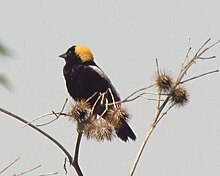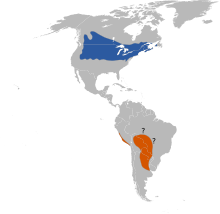Bobolink
| Bobolink | |
|---|---|
 |
|
| Scientific classification | |
| Kingdom: | Animalia |
| Phylum: | Chordata |
| Class: | Aves |
| Order: | Passeriformes |
| Family: | Icteridae |
| Genus: |
Dolichonyx Swainson, 1827 |
| Species: | D. oryzivorus |
| Binomial name | |
|
Dolichonyx oryzivorus (Linnaeus, 1758) |
|
 |
|
| Approximate distribution. Breeding range Non-breeding range | |
The bobolink (Dolichonyx oryzivorus) is a small New World blackbird and the only member of the genus Dolichonyx.
The genus name Dolichonyx is from Ancient Greek dolikhos, "long", and onux, "claw". The specific oryzivorus is from Latin oryza, "rice", and vorare, "to devour"; an old name for this species is "Rice Bird". The English "Bobolink" is from Bob o' Lincoln, describing the call.
Adults are 16–18 cm (6.3–7.1 in) long with short finch-like bills. They weigh about 1 oz (28 g). Adult males are mostly black with creamy napes and white scapulars, lower backs, and rumps. Adult females are mostly light brown, although their coloring includes black streaks on the back and flanks, and dark stripes on the head; their wings and tails are darker. The collective name for a group of bobolinks is a chain.
The bobolink breeds in the summer in North America across much of southern Canada and the northern United States. It migrates long distances, wintering in southern South America in Argentina, Bolivia, Brazil and Paraguay. One bird was tracked migrating 12,000 mi (19,000 km) over the course of the year, often flying long distances up to 1,100 mi (1,800 km) in a single day, then stopping to recuperate for days or weeks.
They often migrate in flocks, feeding on cultivated grains and rice, which leads to them being considered a pest by farmers in some areas. Although bobolinks migrate long distances, they have rarely been sighted in Europe—like many vagrants from the Americas, the overwhelming majority of records are from the British Isles.
The species has been known in the southern United States as the "reedbird," or the "ricebird" from their consumption of large amounts of the grain from rice fields in South Carolina and the Gulf States during their southward migration in the fall. One of the species' main migration routes is through Jamaica, where they're called "butter-birds" and at least historically were collected as food, having fattened up on the aforementioned rice.
...
Wikipedia

